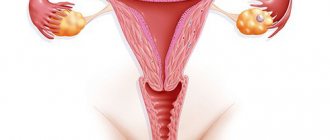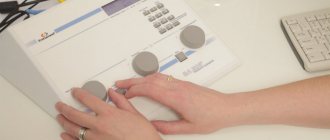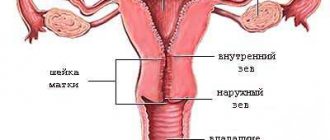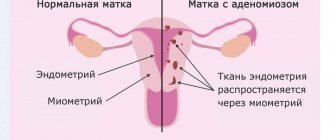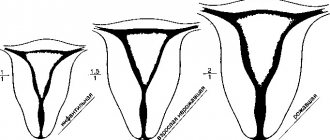Deviation of the uterus from its normal position (retroflexion, bending, bending backward, left or right) is a displacement of this organ in the pelvis. This anatomical position, such as a posterior bend, can be congenital or occurs due to gynecological operations, including surgical abortion, a previous inflammatory process in the appendages and / or insufficiency of ovarian function. Let's talk about this feature of female anatomy, about positions for better conception and useful procedures for the treatment of a posterior bend of the uterus that our clinic offers.
Symptoms of a bent uterus
If the body of the uterus is slightly curved posteriorly, there are no signs. With a more pronounced change in the normal position of the organ, the following are possible:
- discomfort or pain during intimate contacts;
- painful menstruation (algodysmenorrhea), heavier discharge during menstruation, as well as dysfunctional uterine bleeding (usually spotting);
- Difficulty defecating (constipation), which occurs due to compression of the rectum.
Sources
- Eriksson K., Strimling P., Gelfand M., Wu J., Abernathy J., Akotia CS., Aldashev A., Andersson PA., Andrighetto G., Anum A., Arikan G., Aycan Z., Bagherian F ., Barrera D., Basnight-Brown D., Batkeyev B., Belaus A., Berezina E., Björnstjerna M., Blumen S., Boski P., Bou Zeineddine F., Bovina I., Huyen BTT., Cardenas JC., Čekrlija Đ., Choi HS., Contreras-Ibáñez CC., Costa-Lopes R., de Barra M., de Zoysa P., Dorrough A., Dvoryanchikov N., Eller A., Engelmann JB., Euh H., Fang X., Fiedler S., Foster-Gimbel OA., Fülöp M., Gardarsdottir RB., Gill CMHD., Glöckner A., Graf S., Grigoryan A., Gritskov V., Growiec K., Halama P., Hartanto A., Hopthrow T., Hřebíčková M., Iliško D., Imada H., Kapoor H., Kawakami K., Khachatryan N., Kharchenko N., Khoury N., Kiyonari T., Kohút M. , Linh LT., Leslie LM., Li Y., Li NP., Li Z., Liik K., Maitner AT., Manhique B., Manley H., Medhioub I., Mentser S., Mohammed L., Nejat P., Nipassa O., Nussinson R., Onyedire NG., Onyishi IE., Özden S., Panagiotopoulou P., Perez-Floriano LR., Persson MS., Pheko M., Pirttilä-Backman AM., Pogosyan M. , Raver J., Reyna C., Rodrigues R.B., Romanò S., Romero P.P., Sakki I., San Martin A., Sherbaji S., Shimizu H., Simpson B., Szabo E., Takemura K., Tieffi H., Mendes Teixeira ML., Thanomkul N., Tiliouine H., Travaglino GA., Tsirbas Y., Wan R., Widodo S., Zein R., Zhang QP., Zirganou-Kazolea L., Van Lange PAM . Author Correction: Perceptions of the appropriate response to norm violation in 57 societies. // Nat Commun - 2021 - Vol12 - N1 - p.2483; PMID:33903599
- Wong YP., Tan G.C. Virtual meeting in pathology: Time to adapt to the new-norm. // Malays J Pathol - 2021 - Vol43 - N1 - p.1; PMID:33903298
- Roulet J., Vaníček J. Time-reversible and norm-conserving high-order integrators for the nonlinear time-dependent Schrödinger equation: Application to local control theory. // J Chem Phys - 2021 - Vol154 - N15 - p.154106; PMID:33887925
- Wu D., Shang M., Luo X., Wang Z. An L₁-and-L₂-Norm-Oriented Latent Factor Model for Recommender Systems. // IEEE Trans Neural Netw Learn Syst - 2021 - VolPP - NNULL - p.; PMID:33886475
- Talantov P., Niyazov R., Viryasova G., Dranitsyna M., Yasny I. Unapproved clinical trials in Russia: exception or norm? // BMC Med Ethics - 2021 - Vol22 - N1 - p.46; PMID:33879151
- Ajibade I., Boateng G.O. Predicting people why engage in pro-sustainable behaviors in Portland Oregon: The role of environmental self-identity, personal norms, and socio-demographics. // J Environ Manage - 2021 - Vol289 - NNULL - p.112538; PMID:33865024
- Andreoni J., Nikiforakis N., Siegenthaler S. Predicting social tipping and norm change in controlled experiments. // Proc Natl Acad Sci USA - 2021 - Vol118 - N16 - p.; PMID:33859043
- Boum Y., Eyangoh S., Okomo MC. Beyond COVID-19-will self-sampling and testing become the norm? // Lancet Infect Dis - 2021 - Vol - NNULL - p.; PMID:33857408
- Chen Y., Zhao Y. Efficient sparse estimation on interval-censored data with approximated L0 norm: Application to child mortality. // PLoS One - 2021 - Vol16 - N4 - p.e0249359; PMID:33836005
- Newmann SJ., Zakaras JM., Dworkin SL., Withers M., Ndunyu L., Gitome S., Gorrindo P., Bukusi EA., Rocca CH. Measuring Men's Gender Norm Beliefs Related to Contraception: Development of the Masculine Norms and Family Planning Acceptance Scale. // Arch Sex Behav - 2021 - Vol - NNULL - p.; PMID:33821378
Causes of uterine bending
A change in the position of the uterus in the pelvis may be due to factors such as:
- surgical intervention (surgery on the pelvic and abdominal organs), which resulted in the formation of adhesions;
- weakening of the muscles and ligaments of the pelvic floor (for example, after childbirth or due to age-related changes);
- neoplasms in the pelvis;
- anomalies of other pelvic organs;
- inflammatory processes provoked by STIs, if timely and adequate treatment was not carried out;
- endometriosis (uterine pathology, characterized by the spread of the uterine mucosa outside the organ cavity);
- inflammatory processes in the ovaries;
- intestinal pathology;
- pathology of the bladder;
- excessive physical activity.
In addition, the bending of the uterus is often an individual anatomical feature of a woman.
Types of uterine bending
During the examination, various atypical positions of the uterus in the pelvis can be identified, namely:
- retroflexion is an option in which the organ moves towards the rectum. This abnormal position is most often detected during diagnosis;
- anteflexion, when the organ is slightly tilted towards the bladder. In this position, an angle of 90° is formed between the cervix and the body of the uterus. It should be noted that a slight anterior bend may be a normal variant and is usually detected in nulliparous women. In this case, as a rule, after the birth of the child, the position of the uterus becomes correct. With a more significant bend (when the cervix and body of the uterus form an acute angle), they speak of hyperanteflexion of the uterus;
- lateroflexion. In this case, there is a displacement of the organ towards the ovary (either right or left).
The curvature of the uterus can be fixed (as a rule, in this case, inflammatory processes are the basis) or mobile (often occurring in women with low body weight).
Medicines
Photo: fitnesslair.ru
Antibacterial agents are prescribed for inflammatory diseases of the reproductive system. The choice of a specific group of antibiotics is based on the data obtained from a microscopic examination of scrapings from the cervical canal and cervix. As a rule, preference is given to broad-spectrum antibacterial drugs that are capable of destroying both gram-positive and gram-negative microflora. When taking antibiotics, it is important to carefully follow all the doctor’s recommendations, and also not to discontinue the drug yourself or adjust the dose and frequency of administration. This is important, since violation of these rules can lead to the development of resistance of pathogenic microflora to the antibiotic used. As a result, the acute process turns into a chronic one, which threatens the formation of adhesions.
Non-steroidal anti-inflammatory drugs (NSAIDs) are used to reduce the severity of the inflammatory process. Their action is based on inhibition of the enzyme COX (cyclooxygenase), which entails a disruption in the synthesis of prostaglandins from arachidonic acid. This mechanism of action of the drugs provides not only an anti-inflammatory effect, but also antipyretic and analgesic effects.
Vitamin or vitamin-mineral complexes are prescribed for the general strengthening of a woman’s body. As you know, there are currently many representatives of these funds. It is important to note that you should choose “female” vitamin-mineral complexes, since they are filled with all the necessary microelements that are necessary for the normal functioning of a woman’s body. These drugs usually include the following components:
- vitamin A – essential for healthy hair, nails and skin;
- B vitamins (B1, B6, B9, B12, etc.) – participate in metabolic processes and are necessary for the functioning of the nervous and immune systems;
- Vitamin C – plays a key role in the functioning of the immune system;
- vitamin E – necessary for the normal functioning of the gonads;
- copper – maintains skin elasticity;
- iron – participates in the process of hematopoiesis. This mineral is especially important for a woman’s body, which is associated with monthly blood loss during menstruation;
- zinc – participates in metabolic processes, strengthens the immune system;
- calcium – maintains healthy teeth and bones.
In most cases, the course of treatment is 1 month; if necessary, the duration of the course is increased.
Diagnosis of uterine bending
An obstetrician-gynecologist can detect a bend of the uterus during a gynecological examination by bimanual palpation.
To study in more detail the position of the uterus and surrounding organs, as well as to exclude the presence of space-occupying formations, a pelvic ultrasound is performed, which can be performed using abdominal (through the abdominal wall) or transvaginal (inserted into the vagina) sensors. The second method is more informative.
A magnetic resonance imaging (MRI) or computed tomography (CT) scan may also be ordered.
Sometimes hysterosalpingography or echohysterosalpingoscopy is required. The fundamental difference between these methods is that HSG is an x-ray examination, and GSS is an ultrasound examination.
The curvature of the uterus does not affect the course of pregnancy in any way.
Photo
As previously noted, there are simply a huge number of different diagnostic methods. The main one is to perform an ultrasound. What does a uterus look like with a backward bend: photos can be found on a variety of resources that relate to this issue.
Posterior bending of the uterus: causes and consequences, photos and much more can be found on the Internet. This is due to the fact that a similar problem has been known for many years. In various textbooks and magazines you can find images that are defined as a posterior bend of the uterus in the photo. However, a schematic designation of the position of the organs will not allow one to independently determine the presence or absence of a defect.
The photo obtained during an ultrasound examination allows the doctor to make a more accurate diagnosis.
Among the main points we note the following:
- Modern equipment allows you to obtain high-quality images that can be used to make a diagnosis. Only on the basis of such an image does a specialist determine the deviation of the neck from the correct axis.
- The resulting image should be saved. This is due to the fact that all deviations can be interpreted differently.
- When conducting an ultrasound examination, not only the fact of the presence of a bend is determined, but also the reasons for its occurrence. An example is the appearance of neoplasms or the development of an inflammatory process.
- The resulting photo should be protected from environmental influences. In such photographs, it is also important what the transparency of certain areas is. All surface defects can be assessed in a variety of ways.
This and much more is worth considering when considering how diagnostics are carried out. Modern ultrasound equipment provides clear images. Any deviation from the norm should be examined by a doctor.
Treatment
If a uterine flexion is an anatomical feature of the woman, intervention is not required.
If inflammatory processes are the basis, treatment of the underlying disease is carried out. Additionally, physiotherapeutic procedures may be prescribed. If necessary, surgical dissection of adhesions is performed.
The operation is also carried out in the presence of cystic and tumor formations that cause changes in the position of the uterus.
To strengthen the pelvic floor muscles, Kegel exercises may be recommended.
In some cases, a pessary is installed.
How to get pregnant when the uterus is bent?
There is a widespread belief that the bending of the uterus (that is, the retroflexio position) is one of the reasons for the decrease in reproductive function and necessarily requires correction. This is wrong. In the vast majority of cases, women with this anatomical feature do not experience any difficulties in getting pregnant and carrying it to term.
If infertility is diagnosed in a patient with a bent uterus, then, as a rule, it is due to the factors that provoked this bent (for example, an adhesive process due to a chronic inflammatory disease).


